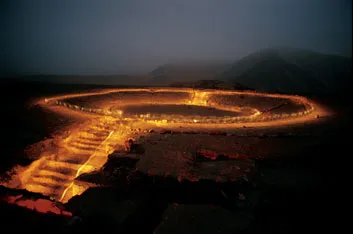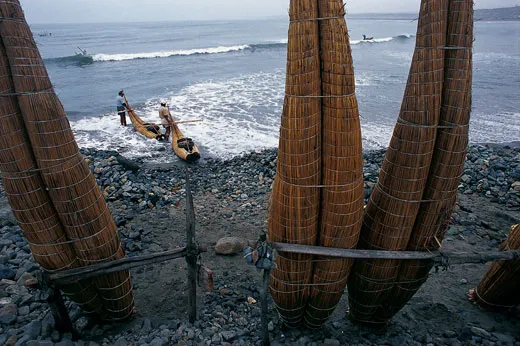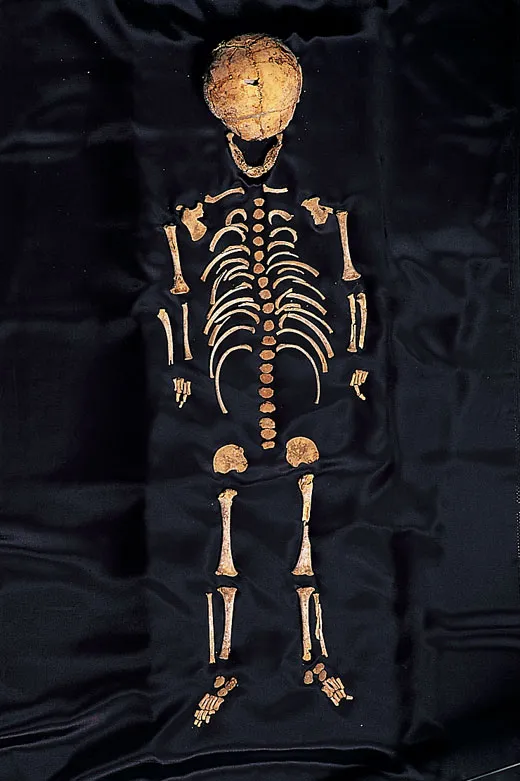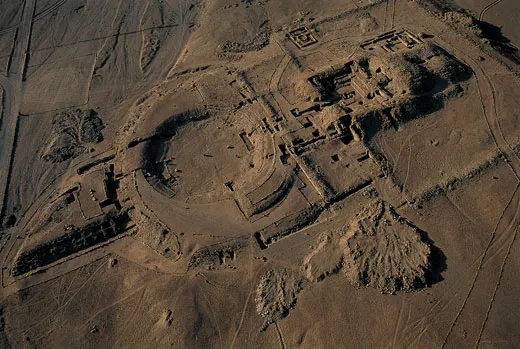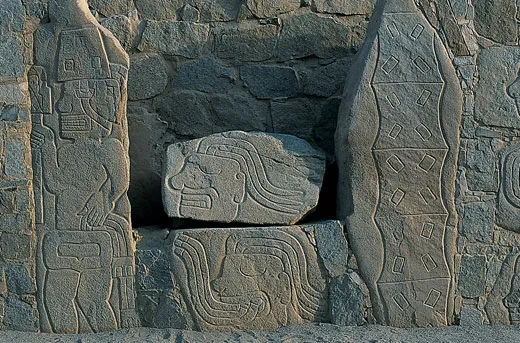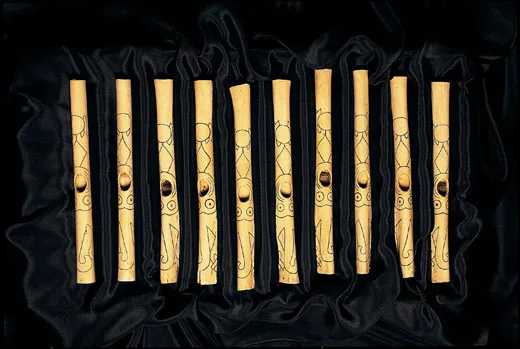First City in the New World?
Peru’s Caral suggests civilization emerged in the Americas 1,000 years earlier than experts believed
Six earth-and-rock mounds rise out of the windswept desert of the SupeValley near the coast of Peru. Dunelike and immense, they appear to be nature’s handiwork, forlorn outposts in an arid region squeezed between the Pacific Ocean and the folds of the Andean Cordillera. But looks deceive. These are human-made pyramids, and compelling new evidence indicates they are the remains of a city that flourished nearly 5,000 years ago. If true, it would be the oldest urban center in the Americas and among the most ancient in all the world.
Research developed by Peruvian archaeologist Ruth Shady Solís of San Marcos University suggests that Caral, as the 150-acre complex of pyramids, plazas and residential buildings is known, was a thriving metropolis as Egypt’s great pyramids were being built. The energetic archaeologist believes that Caral may also answer nagging questions about the long-mysterious origins of the Inca, the civilization that once stretched from modern-day Ecuador to central Chile and gave rise to such cities as Cuzco and Machu Picchu. Caral may even hold a key to the origins of civilizations everywhere.
Though discovered in 1905, Caral first drew little attention, largely because archaeologists believed the complex structures were fairly recent. But the monumental scale of the pyramids had long tantalized Shady. “When I first arrived in the valley in 1994, I was overwhelmed,” she says. “This place is somewhere between the seat of the gods and the home of man.” She began excavations two years later, braving primitive conditions on a tight budget. Fourteen miles from the coast and 120 miles north of Peru’s capital city of Lima, Caral lies in a desert region that lacks paved roads, electricity and public water. Shady, who enlisted 25 Peruvian soldiers to help with the excavations, often used her own money to advance the work.
For two months she and her crew searched for the broken remains of pots and containers, called potsherds, that most such sites contain. Not finding any only made her more excited; it meant Caral could be what archaeologists term pre-ceramic, or existing before the advent of pot-firing technology in the area. Shady eventually concluded that Caral predated Olmec settlements to the north by 1,000 years. But colleagues remained skeptical. She needed proof.
In 1996, Shady’s team began the mammoth task of excavating Pirámide Mayor, the largest of the pyramids. After carefully clearing away several millennia’s worth of rubble and sand, they unearthed staircases, circular walls covered with remnants of colored plaster, and squared brickwork. Finally, in the foundation, they found the preserved remains of reeds woven into bags, known as shicras. The original workers, she surmised, must have filled these bags with stones from a hillside quarry a mile away and laid them atop one another inside retaining walls, gradually giving rise to the city of Caral’s immense structures.
Shady knew that the reeds were ideal subjects for radiocarbon dating and could make her case. In 1999, she sent samples of them to Jonathan Haas at Chicago’s FieldMuseum and to Winifred Creamer at NorthernIllinoisUniversity. In December 2000, Shady’s suspicions were confirmed: the reeds were 4,600 years old. She took the news calmly, but Haas says he “was virtually in hysterics for three days afterward.” In the April 27, 2001, issue of the journal Science, the three archaeologists reported that Caral and the other ruins of the SupeValley are “the locus of some of the earliest population concentrations and corporate architecture in South America.” The news stunned other scientists. “It was almost unbelievable,” says Betty Meggers, an archaeologist at the Smithsonian Institution. “This data pushed back the oldest known dates for an urban center in the Americas by more than 1,000 years.”
What amazed archaeologists was not just the age but the complexity and scope of Caral. Pirámide Mayor alone covers an area nearly the size of four football fields and is 60 feet tall. A 30-foot-wide staircase rises from a sunken circular plaza at the foot of the pyramid, passing over three terraced levels until it reaches the top of the platform, which contains the remains of an atrium and a large fireplace. Thousands of manual laborers would have been needed to build such a mammoth project, not even counting the many architects, craftsmen, supervisors and other managers. Inside a ring of platform pyramids lies a large sunken amphitheater, which could have held many hundreds of people during civic or religious events. Inside the amphitheater, Shady’s team found 32 flutes made of pelican and condor bones. And, in April 2002, they uncovered 37 cornets of deer and llama bones. “Clearly, music played an important role in their society,” says Shady.
The perimeter of Caral holds a series of smaller mounds, various buildings and residential complexes. Shady discovered a hierarchy in living arrangements: large, well-kept rooms atop the pyramids for the elite, ground-level complexes for craftsmen, and shabbier outlying shantytowns for workers.
But why had Caral been built in the first place? More important, why would people living comfortably in small communities perched on the Pacific Ocean with easy access to abundant marine food choose to move inland to an inhospitable desert? If she could answer this question, Shady believed she might begin to unravel one of the knottiest questions in the field of anthropology today: What causes civilizations to arise? And what was it about the desert landscape of Peru’s SupeValley that caused a complex, hierarchical society to flourish there?
Her excavations convinced Shady that Caral had served as a major trade center for the region, ranging from the rain forests of the Amazon to the high forests of the Andes. She found fragments of the fruit of the achiote, a plant still used today in the rain forest as an aphrodisiac. And she found necklaces of snails and the seeds of the coca plant, neither of which was native to Caral. This rich trading environment, Shady believes, gave rise to an elite group that did not take part in the production of food, allowing them to become priests and planners, builders and designers. Thus, the class distinctions elemental to an urban society emerged.
But what sustained such a trading center and drew travelers to it? Was it food? Shady and her team found the remains of sardines and anchovies, which must have come from the coast 14 miles to the west, in the excavations. But they also found evidence that the Caral people ate squash, sweet potatoes and beans. Shady theorized that Caral’s early farmers diverted area rivers into trenches and canals, which still crisscross the SupeValley today, to irrigate their fields. But because she found no traces of maize (corn) or other grains, which can be traded or stored and used to tide a population over in difficult times, she concluded that Caral’s trade leverage was not based on stockpiling food supplies.
It was evidence of another crop in the excavations that gave Shady the best clue to the mystery of Caral’s success. In nearly every excavated building, her team discovered great quantities of cotton seeds, fibers and textiles. Her theory fell into place when a large fishing net, unearthed at an unrelated dig on Peru’s coast, turned out to be as old as Caral. “The farmers of Caral grew the cotton that the fishermen needed to make the nets,” Shady speculates. “And the fishermen gave them shellfish and dried fish in exchange for these nets.” In essence, the people of Caral enabled fishermen to work with larger and more effective nets, which made the resources of the sea more readily available. The Caral people probably used dried squash as flotation devices for nets and also as containers, thus obviating any need for ceramics.
Eventually Caral would spawn 17 other pyramid complexes scattered across the 35-square-mile area of the SupeValley. Then, around 1600 B.C., for reasons that may never be answered, the Caral civilization toppled, though it didn’t disappear overnight. “They had time to protect some of their architectural structures, burying them discreetly,” says Shady. Other nearby areas, such as Chupacigarro, Lurihuasi and Miraya, became centers of power. But based on Caral’s size and scope, Shady believes that it is indeed the mother city of the Incan civilization.
She plans to continue excavating Caral and says she would someday like to build a museum on the site. “So many questions still remain,” she says. “Who were these people? How did they control the other populations? What was their main god?”
